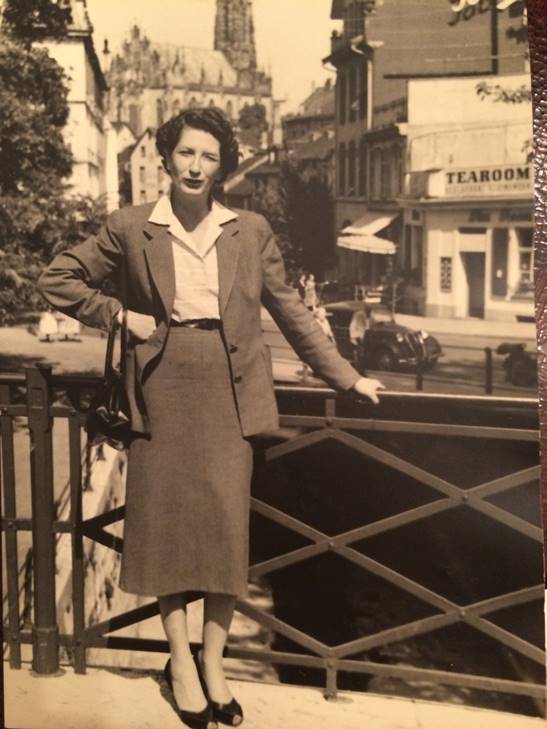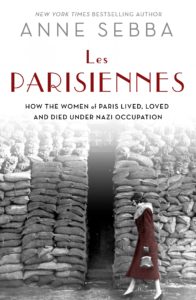
Odette Fabius, member of the Résistance and survivor of the Ravensbruck camp. Here, she proudly wears a Lanvin suit while being an active résistante.
By Anne Sebba (Guest Contributor)
Mentioning resistance in France during World War Two conjures up images of brave citizens blowing up railroad tracks, assassinating Nazi soldiers or broadcasting information on secret wireless sets. And it’s usually men who are involved. But there were many types of resistance. For women, especially those trapped in Paris who had to encounter Germans possibly on a daily basis, there were constantly decisions to be made: should you walk out of a café if the enemy came in, could you hide a downed airman before moving him on to a safe house or even distribute resistance documents and pamphlets? Some women, concerned for the safety of their children or elderly parents, decided that they would use fashion and keeping stylish as a weapon of resistance. Yet, at a time when materials were rationed and often hard to come by, remaining fashionable was far from trivial for Parisiennes throughout the War. It became a matter of personal and national pride to dress in as beautiful and outrageous a way as possible.
For many women this was the best revenge they could exert on their German occupiers. The writer Colette, in Paris throughout the War, observed young women and the ridiculous concoctions on their heads of flowers, vegetables, straw, cascades of ribbon and even an upside down bird concluding that they were driven by ‘the terrible rage to live.’
Reflecting on this for the past five years as I’ve been writing a book about Parisian women in wartime, I’ve concluded that while British and American women could wear smart military uniforms to show they were resisting evil, French women, after the armistice, had no way of showing they were on the side of the morally righteous. So flaunting fashionably ridiculous hats and short skirts with large power sleeves was often the best they could do. From the moment war was declared, magazines played a role urging women to ‘stay how they (their menfolk) would like to see you. Not ugly… The men want to think of you looking how you did when they said goodbye, pretty and soignée.’ They argued that the Germans might be running the country but they could not destroy the pride and the sense of superiority in fashion that Parisiennes considered was theirs.
Those magazines that continued, even with limited paper supplies, became increasingly popular during the War years. They often gave advice on how to adapt existing items including patterns for dresses made of several different fabrics – not intrinsically beautiful but fashionable by force of circumstance. Shoes were now made of cork or wood and resourceful girls would spend hours artfully covering them with scraps of fabric trying to make them chic. Throughout the War, finding silk stockings (other than those costing 300 francs on the black market, ten times the price of a pre-war pair) caused particular difficulties since it was considered distinctly unladylike in France to be seen without stockings. Yet wearing trousers, insufficiently femini ne, was in theory banned according to an unenforceable law dating from 1800 that was reinforced by Vichy as well as individual prefects who equated trouser wearing with female emancipation. Elizabeth Arden invented a miracle bottle of iodine dye sold in three shades: flesh, gilded flesh and tanned flesh marketed as ‘the silk on your legs without silk stockings.’ Some women also became adept at painting a straight black line up their calves to imitate the seam of a real stocking. But others, especially women resisters working as couriers or delivering leaflets, took to wearing culottes – trousers disguised as a skirt – since traveling by bicycle was essential and it was important for them not to draw attention to themselves. For most women in wartime France, fashion was a question of overcoming shortages and deprivation caused by the enemy and a determination to remain elegant was paramount.
ne, was in theory banned according to an unenforceable law dating from 1800 that was reinforced by Vichy as well as individual prefects who equated trouser wearing with female emancipation. Elizabeth Arden invented a miracle bottle of iodine dye sold in three shades: flesh, gilded flesh and tanned flesh marketed as ‘the silk on your legs without silk stockings.’ Some women also became adept at painting a straight black line up their calves to imitate the seam of a real stocking. But others, especially women resisters working as couriers or delivering leaflets, took to wearing culottes – trousers disguised as a skirt – since traveling by bicycle was essential and it was important for them not to draw attention to themselves. For most women in wartime France, fashion was a question of overcoming shortages and deprivation caused by the enemy and a determination to remain elegant was paramount.
Anne Sebba is former foreign correspondent for Reuters who has written ten books, mostly biographies of women, including Enid Bagnold, Mother Teresa, Laura Ashley, Jennie Churchill and Wallis Simpson (aka That Woman). She makes regular TV appearances and her latest book is Les Parisiennes: How the women of Paris Lived, Loved and Died under Nazi Occupation (St Martin’s Press).

